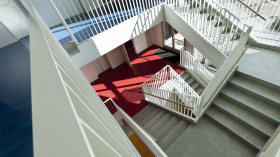A wise security strategy
 Cases of consumers opting for the cheapest security solution as opposed to best value are sadly not unusual. Unfortunately, all too many have regretted a decision that has, in the longer term, proven costly: and not just in financial terms.
Cases of consumers opting for the cheapest security solution as opposed to best value are sadly not unusual. Unfortunately, all too many have regretted a decision that has, in the longer term, proven costly: and not just in financial terms.
Schools are complex environments that have to strike a balance between ensuring smooth access and egress for the pupils and teachers whilst restricting access to unauthorised visitors. The possible array of security incidents that can occur within a school is very wide. Potential for theft, arson and violence – including attacks on teachers – are just a few examples from, sadly, a more extensive list.
Having been invited to write an article for this publication, it would have been easy to write a feature offering guidance on what security solutions should be implemented within the education sector. However, having conducted a preliminary search on the internet, it is quite clear that there are numerous reputable websites already offering excellent advice.
These websites include both government-related and teaching association websites. All offer more extensive advice than I could possibly cram into my allotted word allocation. In addition, of course, there is always the phone call to the local police force Crime Reduction Officer who is well versed in crime prevention. The local Crime Reduction Officer will be aware of local crime patterns and is able to provide advice that is bespoke to each individual school or college. As an alternative approach, I started to think about the all too frequent cases of customers confusing cheapness with best value. Unfortunately, this confusion is witnessed across many sectors and is not unique to the education sector.
No compromises on security
Providing a safe environment in which our children can learn and thrive is an issue that is, I have to declare, particularly personal to me. Indeed, anyone leaving their own children in the trust of a school will share my interest. With two beautiful daughters in the education system and an indelible memory of the 1996 Dunblane Primary School massacre, it has frequently crossed my mind that I hope the security, safety and education of my children are not compromised for the sake of a financial saving.
Major incidents within schools are, thankfully, relatively few. However, when those major incidents do occur, they are the ones that hit the headlines. Emotionally, nothing moves us more than child-related news. When we see the dreadful famines in Africa, it is the pictures of the starving children that persuade us to donate; when we see people suffering through illnesses, it is the images of sick children that call us to action; and, when we see the tragic stories on the news, it is those that involve children, such as the Dunblane massacre, that fill us with greatest sadness and most anger.
The fact that parents and guardians leave their most valued treasures to the trust of a school on a weekly basis is testament to the professionalism of the local authorities, governing bodies and head teachers that provide our children with a safe and secure learning environment.
Invisible fortress
I have been fortunate to witness just how my own daughters’ schools have, thankfully, taken security seriously. Their respective schools have achieved the required balance between security and aesthetics. The security solutions they implement are evident but not prominent. To the layman it may appear that there are no security features – that is a tribute to clever design. Their schools have implemented security solutions that compliment the very fabric of the school. Their primary school was newly built a year before they started their journey into education.
The architects should be applauded for considering security at the design stage. There are multiple entrances and exits for fire safety, yet the main entrance is funneled to one central point. This ensures there is no ‘unauthorised’ access to the building. A secure perimeter is in place: the border maximises use of the natural hedging where possible and utilises secure fencing at the weak points and offers solid entry gates at its central point. This all contributes to providing a boundary that discourages the opportunist criminal and a boundary doesn’t make the children feel they are within a fortress.
Their senior school, an older and much larger school, has faced greater challenges. It is a multi-sited complex that has given consideration to the basics and more. IT equipment is kept off the ground floor; there is natural surveillance from windows across open spaces, playgrounds and car parks; valuable assets are property marked; lighting is plentiful and it has out-of-hours usage so it would be difficult for a criminal to sneak around the complex unnoticed. Any refurbished areas build in security at the design stage.
Difficult times
We are all in the tightening jaws of a very challenging economic climate. Traditionally, in periods of difficult economic times and increasing unemployment, crime levels rise. Current austerity measures are tough, especially in the public sector. Yet when we hear of the economic situation in Greece, the potential of Italy following suit and, nearer to home, the situation in the Republic of Ireland, we seem to appreciate that these measures are painful yet necessary. Just like our own household or corporate budgets, the country must live within its means and that necessitates cut backs and forsaking the ‘nice to haves’.
As a major component of the public sector, schools are integral to a sector bearing the brunt of cuts and reduced budgets. Schools therefore must look at where they can save money. They do not wish to compromise on the quality of the education they provide so they will inevitably include the supplementary areas when reviewing spending. Security, like the core education delivery, should be ring-fenced. The consequences that a breach of security can cause can be disruptive, harmful to a hard earned reputation or, at worse, lead to closure of the school.
No incidents, security works
Many security measures require little or no funding. Ensuring staff are clear on security procedures, locking the gates during the day, ensuring visitors (including parents) are not permitted to walk around a school unaccompanied are all simple, effective and cheap measures that make a difference.
It would be easy to consider cutting the security budget. It is a sad fact that the true contribution of security is often only fully appreciated after it has been reduced or removed. Successful security is security that works. It is a deterrent, it helps identify the culprits, it protects assets, and it protects people. Yet because it works, because there are no incidents, the tendency is to think it is not required. Wrong. There are no incidents because security is doing its job well.
When considering the security required for your school, be clear as to what threats you face, what solutions you require and then ensure that you procure the best you can afford. Ensure your security is installed and/or operated by companies that have proved their competence in their field.
Security suppliers
Security is a specialised profession backed by industry standards and best practice. Source a company that has been independently inspected so that their competence has been proven. Such companies can be found, for example, via www.nsi.org.uk. NSI-approved companies installing security systems or providing guarding services are required to screen their staff to industry standard BS7858, thus providing additional peace of mind that contractors on site have been subject to pre-employment checks.
The quality companies have proven their credentials by opening their processes and procedures to independent inspection. They are the ones that have invested to demonstrate that they comply with industry best practice – as a minimum.
Investing in proven companies provides peace of mind that your security has been properly implemented by professional contractors. A specialised, competent contractor can ultimately save you money; protect your assets, your staff, your pupils and your reputation. When it comes to investing in our education system, a properly considered investment in security really can make a big difference.
Written by Chris Pinder, National Security Inspectorate
Latest News
30/10/2025 - 01:28
In the wake of the Raac crisis, the DfE spent £5 million on research into the condition of school buildings, which is due to conclude in spring 2026.
30/10/2025 - 01:09
Malmesbury Primary School in Wiltshire has submitted plans for a major expansion, funded by entrepreneur James Dyson.
30/10/2025 - 00:55
Monday's Every Pair Tells a Story campaign to protest to highlight the national crisis in SEND provision.
29/10/2025 - 09:19
Estimated data from the Department for Education reveals that 470,000 pupils under 16s use local authority funded transport to get to school.
28/10/2025 - 09:29
Timeline set for removal of Reinforced Autoclaved Aerated Concrete







